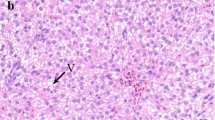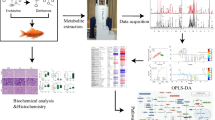Abstract
The sea lamprey (Petromyzon marinus) is a destructive invasive species in the Great Lakes that contributed to the collapse of native fish populations in the mid-1900s. 3-Trifluoromethyl-4-nitrophenol (TFM) is a selective pesticide that has been applied to sea lamprey infested tributaries of the Great Lakes to kill larvae since the 1960s and has reduced the populations by as much as 90%. However, the metabolism of TFM by sea lamprey and non-target species is not fully illuminated. Elucidation of TFM metabolism is critical for understanding its mode of action and possible environmental impact. Here, we describe the screening, identification, synthesis and structural characterization of TFM metabolites in livers from sea lamprey and three non-target species that differ in their ability to survive TFM exposure. We identified glucuronidation, sulfation, N-acetylation, glutathione conjugation, and aromatic nitro group reduction as potential detoxification mechanisms. Seven metabolites were synthesized for use as markers of TFM metabolism in fish. Quantitative 1H NMR was used to assay synthesized metabolite stock solutions that were then used as standard material to develop a quantitative LC-MS/MS method for TFM metabolites.






Similar content being viewed by others
References
Mullett K, Sullivan P. Sea lamprey control in the Great Lakes. http://www.glfc.org/pubs/slcp/annual_reports/ANNUAL_REPORT_2016.pdf. Great Lakes Fishery Commission; 2016.
[Available from: http://www.glfc.org/.
Applegate VC, Howell JH, Smith MA. Use of mononitrophenols containing halogens as selective sea lamprey larvicides. Science. 1958;127(3294):336–8.
Storbeck K-H, Kolar NW, Stander M, Swart AC, Prevoo D, Swart P. The development of an ultra performance liquid chromatography-coupled atmospheric pressure chemical ionization mass spectrometry assay for seven adrenal steroids. Anal Biochem. 2008;372(1):11–20.
Boogaard MA, Bills TD, Johnson DA. Acute toxicity of TFM and a TFM/niclosamide mixture to selected species of fish, including lake sturgeon (Acipenser fulvescens) and mudpuppies (Necturus maculosus), in laboratory and field exposures. J Great Lakes Res. 2003;29(Supplement 1(0)):529–41.
Lech JJ, Statham CN. Role of glucuronide formation in the selective toxicity of 3-trifluoromethyl-4-nitrophenol (TFM) for the sea lamprey: comparative aspects of TFM uptake and conjugation in sea lamprey and rainbow trout. Toxicol Appl Pharmacol. 1975;31(1):150–8.
Lech JJ, Costrini NV. In vitro and in vivo metabolism of 3-trifluoromethyl-4-nitrophenol (TFM) in rainbow trout. Comp Gen Pharmacol. 1972;3(10):160–6.
Kawatski JA, Bittner MA. Uptake, elimination, and biotransformation of the lampricide 3-trifluoromethyl-4-nitrophenol (TFM) by larvae of the aquatic midge chironomus tentans. Toxicology. 1975;4(2):183–94.
Bussy U, Chung-Davidson YW, Li K, Li W. Phase I and phase II reductive metabolism simulation of nitro aromatic xenobiotics with electrochemistry coupled with high resolution mass spectrometry. Anal Bioanal Chem. 2014;406(28):7253–60.
Bussy U, Chung-Davidson YW, Li K, Li W. A quantitative assay for reductive metabolism of a pesticide in fish using electrochemistry coupled with liquid chromatography tandem mass spectrometry. Environ Sci Technol. 2015;49(7):4450–7.
Johanning K, Hancock G, Escher B, Adekola A, Bernhard MJ, Cowan-Ellsberry C, et al. Assessment of metabolic stability using the rainbow trout (Oncorhynchus mykiss) liver S9 fraction. Curr Protoc Toxicol. 2012;Chapter 14:Unit 14 0 1–28.
Smith WB. Observations on the reduction of aryl nitro groups with palladium-sodium borohydride. J Heterocycl Chem. 1987;24(3):745–8.
Duesel BF, Godfrey W. Process for the preparation of n-acetyl-p-aminophenol (apap). Google Patents; 1967.
Ho K-L, Murphy MB, Wan Y, Fong BMW, Tam S, Giesy JP, et al. Synthesis and characterization of bromophenol glucuronide and sulfate conjugates for their direct LC-MS/MS quantification in human urine as potential exposure markers for polybrominated diphenyl ethers. Anal Chem. 2012;84(22):9881–8.
Bussy U, Giraudeau P, Tea I, Boujtita M. Understanding the degradation of electrochemically-generated reactive drug metabolites by quantitative NMR. Talanta. 2013;116(0):554–8.
Lohmann W, Karst U. Simulation of the detoxification of paracetamol using on-line electrochemistry/liquid chromatography/mass spectrometry. Anal Bioanal Chem. 2006;386(6):1701–8.
Bussy U, Delaforge M, El-Bekkali C, Ferchaud-Roucher V, Krempf M, Tea I, et al. Acebutolol and alprenolol metabolism predictions: comparative study of electrochemical and cytochrome P450-catalyzed reactions using liquid chromatography coupled to high-resolution mass spectrometry. Anal Bioanal Chem. 2013;405(18):6077–85.
Bussy U, Boujtita M. Advances in the electrochemical simulation of oxidation reactions mediated by cytochrome p450. Chem Res Toxicol. 2014;27(10):1652–68.
Nematollahi D, Shayani-Jam H, Alimoradi M, Niroomand S. Electrochemical oxidation of acetaminophen in aqueous solutions: kinetic evaluation of hydrolysis, hydroxylation and dimerization processes. Electrochim Acta. 2009;54(28):7407–15.
Madsen KG, Olsen J, Skonberg C, Hansen SH, Jurva U. Development and evaluation of an electrochemical method for studying reactive phase-I metabolites: correlation to in vitro drug metabolism. Chem Res Toxicol. 2007;20(5):821–31.
Bussy U, Giraudeau P, Silvestre V, Jaunet-Lahary T, Ferchaud-Roucher V, Krempf M, et al. In situ NMR spectroelectrochemistry for the structure elucidation of unstable intermediate metabolites. Anal Bioanal Chem. 2013;405(17):5817–24.
Burkhardt GN. 89. The action of chlorosulphonic acid on phenol and p-cresol at low temperatures. J Chem Soc (Resumed). 1933;337.
Buhler DR, Rasmusson ME. Reduction of p-nitrobenzoic acid by fishes. Arch Biochem Biophys. 1968;124(0):582–95.
Brune K, Renner B, Tiegs G. Acetaminophen/paracetamol: a history of errors, failures and false decisions. Eur J Pain. 2014:n/a-n/a.
Corbett MD, Corbett BR, Hannothiaux MH, Quintana SJ. Metabolic activation and nucleic acid binding of acetaminophen and related arylamine substrates by the respiratory burst of human granulocytes. Chem Res Toxicol. 1989;2(4):260–6.
James LP, Mayeux PR, Hinson JA. Acetaminophen-induced hepatotoxicity. Drug Metab Dispos. 2003;31(12):1499–506.
Madsen KG, Skonberg C, Jurva U, Cornett C, Hansen SH, Johansen TN, et al. Bioactivation of diclofenac in vitro and in vivo: correlation to electrochemical studies. Chem Res Toxicol. 2008;21(5):1107–19.
Monks TJ, Lau SS. The pharmacology and toxicology of polyphenolic-glutathione conjugates. Annu Rev Pharmacol Toxicol. 1998;38:229–55.
Nakayama Wong LS, Lame MW, Jones AD, Wilson DW. Differential cellular responses to protein adducts of naphthoquinone and monocrotaline pyrrole. Chem Res Toxicol. 2010;23(9):1504–13.
Bussy U, Chung-Davidson Y-W, Buchinger TJ, Li K, Smith SA, Jones DA, et al. Metabolism of a sea lamprey pesticide by fish liver enzymes. Part B. Method development and application in quantification of TFM metabolites formed in vivo. https://doi.org/10.1007/s00216-017-0831-7
Ellis F. Paracetamol—a curriculum resource. Osborne C, Pack M, editors: Royal Society of Chemistry; 2002. 26 p.
Lohmann W, Karst U. Generation and identification of reactive metabolites by electrochemistry and immobilized enzymes coupled on-line to liquid chromatography/mass spectrometry. Anal Chem. 2007;79(17):6831–9.
Boisseau R, Bussy U, Giraudeau P, Boujtita M. In situ ultrafast 2D NMR spectroelectrochemistry for real-time monitoring of redox reactions. Anal Chem. 2015;87(1):372–5.
Bussy U, Boujtita M. Review of advances in coupling electrochemistry and liquid state NMR. Talanta. 2015;136:155–60.
Dusza JP, Joseph JP, Bernstein S. The preparation of estradiol-17β sulfates with triethylamine-sulfur trioxide. Steroids. 1985;45(3–4):303–15.
Levsen K, Schiebel H-M, Behnke B, Doetzer R, Dreher W, Elend M, et al. Structure elucidation of phase II metabolites by tandem mass spectrometry: an overview. J Chromatogr A. 2005;1067(1–2):55–72.
Dunlop ES, McLaughlin R, Adams JV, Jones M, Birceanu O, Christie MR, et al. Rapid evolution meets invasive species control: the potential for pesticide resistance in sea lamprey. Can J Fish Aquat Sci. 2017;1–17.
Acknowledgements
This research was supported by the Great Lakes Fishery Commission. The authors thank Dr. Daniel Holmes from Michigan State University NMR core facility for his technical support. The authors also thank Andrew Paul Buchinger and Professor Kim Scribner for the gifts of fresh blue gill liver and fresh lake sturgeon liver. A.D.J. was supported by the USDA National Institute of Food and Agriculture and Hatch project MICL-02143.
Author information
Authors and Affiliations
Corresponding author
Ethics declarations
Animal tissues used in analyses were collected by staff of USGS Lake Huron Biological Station, Millersburg, MI 49759, USA. Experimental protocols involving the handling of fishes were carried out in accordance with United States federal guidelines for care and use of animals and were approved by the American Fisheries Society through the “Use of Fishes in Research Committee, 2014”.
Conflict of interest
The authors declare that they have no conflict of interest.
Electronic supplementary material
ESM 1
(PDF 29 kb)
Rights and permissions
About this article
Cite this article
Bussy, U., Chung-Davidson, YW., Buchinger, T. et al. Metabolism of a sea lamprey pesticide by fish liver enzymes part A: identification and synthesis of TFM metabolites. Anal Bioanal Chem 410, 1749–1761 (2018). https://doi.org/10.1007/s00216-017-0830-8
Received:
Revised:
Accepted:
Published:
Issue Date:
DOI: https://doi.org/10.1007/s00216-017-0830-8




